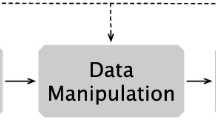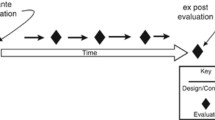Abstract
Structural complexity metrics have been widely used to assess quality of an artefact. Researchers in past have defined complexity metrics to assess the quality of multidimensional models for data warehouse. These metrics have been defined considering various elements like facts, dimensions, dimension hierarchies etc., but have not taken into account the relationships among these elements of the models. In our previous work, a comprehensive complexity metric for multidimensional models for data warehouse has been proposed which not only considered complexity due to the elements but also structural complexity due to relationships among these elements. However, the proposal lacks theoretical and empirical validation of the metric. Hence, practical utility of the metric could not be established. This paper validates the proposed metric theoretically as well as empirically. The theoretical validation using Briand’s framework shows that the proposed metric satisfies most of the properties required for a complexity measure. Empirical validation is carried out to observe the relationship between the complexity metric and understandability-a sub-characteristic of maintainability of multidimensional models. The results show that the metric has significant positive correlation with understandability of multidimensional models. Predictive model based on Ordinal Regression proposed in this work indicates that the proposed complexity metric may act as objective indicator for understandability as accuracy of the model is 86.3 % which is quite high.


Similar content being viewed by others
References
Basili VR, Rombach HD (1988) The TAME Project: towards improvement-oriented software environment. IEEE Trans Softw Eng 14(6):758–773
Batra D (2007) Cognitive complexity in data modelling: causes and recommendations. Requir Eng 12:231–244
Berenguer G, Romero R, Trujillo J, Serrano M, Piattini M (2005) A set of quality indicators and their corresponding metrics for conceptual models of data warehouses. Proceeding of 7th International conference on Data Warehousing and Knowledge Discovery (Lecture Notes in Computer), Denmark, 22–26 August 2005, pp.95–104
Boehm B (1981) Software engineering economics. Prentice Hall, New Jersey
Briand LC, Morasca S, Basili VR (1996) Property based software engineering measurement. IEEE Trans Softw Eng 22:68–86
Briand LC, Morasca S, Basili VR (1997) Response to: comments “property- based software engineering measurement: refining the additivity properties”. IEEE Trans Softw Eng 22(3):196–197
Briand LC, Wuest J, Ikonomovski S and Lounis H (1999) Investigation of quality factors in object oriented designs: an industrial case study. Proceedings of 21st International Conference on Software Engineering, Los Angeles, pp 345–354
Briand LC, Morasca S, Basili VR (1999b) Defining and validating measures for object-based high-level design. IEEE Trans Softw Eng 25(5):722–743
Canfora G, Garcia F, Piattin M, Ruiz F, Visaggio CA (2005) A family of experiments to validate metrics for software process models. J Syst Softw 77(2):113–129
Card DN, Agresti WW (1988) Measuring software design complexity. J Syst Softw 8(3):185–197
Carver J, Jaccheri L, Morasca S, Shull F (2003) Using empirical studies during software courses. Experimental Software Engineering Research Network (LNCS 2765), pp. 81–103
Si-Saıd Cherfi S, Prat N (2003) Multidimensional schemas quality: assessing and balancing analyzability and simplicity, ER Workshop 2003, pp. 140–151
Chidamber SR, Kemerer CF (1994) A metrics suite for object-oriented design. IEEE Trans Softw Eng 20(6):476–493
Ciolkowski M, Shull F, Biffle S (2002) A family of experiments to investigate the influence of context on the effect of inspection techniques. 6th International Conference on empirical assessment in software engineering, Keele, UK, pp 48–60
Costagliola G, Ferrucci F, Tortora G, Vitiello G (2005) Class points: an approach for the size estimation of object-oriented systems. IEEE Trans Softw Eng 31(1):52–74
Fenton NE, Pfeelger SL (1997) Software metrics – a rigorous and practical approach. International Thomson Computer Press, London
Finkelstein L (2003) Widely, strongly and weakly defined measurement. Measurement 34(1):39–48
Flood RL, Carson ER (1988) Dealing with complexity: an introduction to the theory and application of system sciences. Plenum, New York
Gemino A, Wand Y (2004) A framework for empirical evaluation of conceptual modelling techniques. Requir Eng 9:248–260
Genero M, Esperanza M, Visaggio A, Canfora G, Piattini M (2007) Building measure-based prediction models for UML class diagram maintainability. Empir Softw Eng 12(5):517–549
Genero M, Poels G, Piattini M (2008) Defining and validating metrics for assessing the understandability of entity–relationship diagrams. Data Knowl Eng 64(3):534–557
Gosain A, Nagpal S, Sabharwal S (2011a) Quality metrics for conceptual models for data warehouse focusing on dimension hierarchies. ACM SIGSOFT Software Engineering Notes 36(4):1–5
Gosain A, Sabharwal S, Nagpal S (2011b) Assessment of quality of data warehouse multidimensional model. Int J Inf Qual 2(4):344–358
Gosain A, Nagpal S, Sabharwal S (2013) Validating dimension hierarchy metrics for the understandability of multidimensional models for data warehouse. To appear in IET software
Henry S, Kafura D (1981) Software structure metrics based on information flow. IEEE Trans Softw Eng 7(5):510–518
Inmon WH (1997) Building data warehouse. Wiley, New York
IS0/IEC 9126 (2001)-Software engineering –product quality – part 1: quality model
Kaner C (2004) Software engineering metrics: what do they measure and how? Proceedings of the 10th IEEE Intertnational Software Metrics Symposium (Metrics 2004), Chicago, pp: 1–10
Kesh S (1995) Evaluating the quality of entity relationship model. Inf Softw Technol 37(12):681–689
Kitchenhem B, Pfleeger S, Pickard L, Jones P, Hoaglin D, EI Emam K, Rosenberg J (2002) Preliminary guidelines for empirical research in software engineering. IEEE Trans Softw Eng 28(8):721–734
Lindland OI, Sindre G, Solvberg A (1994) Understanding quality in conceptual modelling. IEEE Softw 11(2):42–49
Malinowski E, Zimanyi E (2006) Hierarchies in a multidimensional model: from conceptual modeling to logical representation. Data Knowl Eng 59(2):348–377
Mishra S, Akman I, Koyunku M (2011) An inheritance complexity metric for object-oriented code: a cognitive approach. Sadhana (Indian Academy of Sciences) 36(3):317–337
Moody DL (2005) Theoretical and practical issues in evaluating the quality of conceptual models: current state and future directions. Data Knowl Eng 55(3):243–276
Moody DL, Shank G (2003) Improving the quality of data models: empirical validation of quality management framework. Int J Inf Syst 28(6):619–650
Nagpal S, Gosain A, Sabharwal S (2012) Complexity metric for multidimensional model for data warehouse. International Information Technology Conference and Exhibition, Pune, 3–5 Sep 2012
Olague HM, Etzkorn LH, Messimer SL, Delugach HS (2008) An empirical validation of object-oriented class complexity metrics and their ability to predict error-prone classes in highly iterative, or agile, software: a case study. J Softw Maintenance Evol Res Pract 20(3):171–197
Olive A (2002) Specific relationship types in conceptual modeling: the cases of generic and with common participants. keynote lecture In: 4th International Conference on Enterprise Information Systems (ICEIS’ 02), Ciudad Real, 3–6 April 2002
Poels G, Dedene G (2000) Distance: A framework for software measure construction. Research Report DTEW9937, Dept Applies Economics Katholieke Universiteit Lueven, Belgium
Reijers HA, Mendling J (2011) A study into the factors that influence the understandability business process model. IEEE Trans Syst Man Cybern Part A 41:449–462
Rizzi S, Abello A, Lechtenbörger J, Trujillo J (2006) Research in data warehouse modelling: dead or alive? Proceedings 9th International Workshop on Data Warehousing and OLAP, Arlington, pp 3–10
Schneidewind N (1992) Methodology for validating software metrics. IEEE Tans Softw Eng 18(5):410–422
Schuff D, Karen Corral, Turetken O (2011) Comparing understandability of alternative data warehouse schemas: an empirical study. Decis Support Syst 52(1):9–20
Calero C, Piattini M, Pascual C, Serrano, MA (2001) Towards data warehouse quality metrics. 3rd International workshop on design and management of data warehouses, Interlaken, Switzerland
Serrano M, Calero C, Piattini M (2002) Validating metrics for data warehouse. IEE Proc Softw 149(5):161–166
Serrano M, Calero C, Piattini M (2005) An experimental replication with data warehouse metrics. Int J Data Warehouse Min 1(4):1–21
Serrano M, Trujillo J, Calero C, Piattini M (2007) Metrics for data warehouse conceptual models understandability. J Inf Softw Technol 49(8):851–870
Serrano M, Calero C, Sahraouli H, Piattini M (2008) Empirical studies to assess the undesrstandability of data warehouse schemas using structural metrics. Softw Qual J 16(1):79–106
Weyuker EJ (1988) Evaluating software complexity measure. IEEE Trans Softw Eng 14:1357–1365
Wohlin C, Runeson P, Host M, Ohlsson MC, Regnell B, Wesslen A (2000) Experimentation in software engineering. Kluwer Academic, Norwell
Zuse H (1998) Framework of software measurement. Walter de Guyter, Berlin, 1998. http://www.norusis.com/pdf/ASPC_v13.pdf. Accessed July 2012
Author information
Authors and Affiliations
Corresponding author
Rights and permissions
About this article
Cite this article
Nagpal, S., Gosain, A. & Sabharwal, S. Theoretical and empirical validation of comprehensive complexity metric for multidimensional models for data warehouse. Int J Syst Assur Eng Manag 4, 193–204 (2013). https://doi.org/10.1007/s13198-013-0158-5
Received:
Revised:
Published:
Issue Date:
DOI: https://doi.org/10.1007/s13198-013-0158-5




